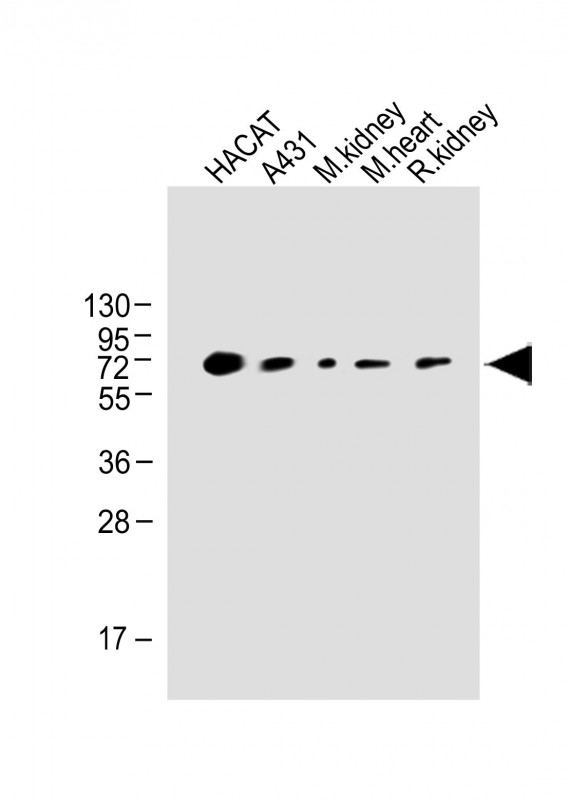OTOP1 Antibody (Center)
Affinity Purified Rabbit Polyclonal Antibody (Pab)
- 产品详情
- 实验流程
- 背景知识
Application
| WB, IHC-P, E |
|---|---|
| Primary Accession | Q7RTM1 |
| Other Accession | Q7M734, Q80VM9, NP_819056.1 |
| Reactivity | Human, Rat, Mouse |
| Predicted | Rat |
| Host | Rabbit |
| Clonality | Polyclonal |
| Isotype | Rabbit IgG |
| Calculated MW | 67353 Da |
| Antigen Region | 360-388 aa |
| Gene ID | 133060 |
|---|---|
| Other Names | Otopetrin-1, OTOP1 |
| Target/Specificity | This OTOP1 antibody is generated from rabbits immunized with a KLH conjugated synthetic peptide between 360-388 amino acids from the Central region of human OTOP1. |
| Dilution | WB~~1:2000 IHC-P~~1:100~500 E~~Use at an assay dependent concentration. |
| Format | Purified polyclonal antibody supplied in PBS with 0.05% (V/V) Proclin 300. This antibody is purified through a protein A column, followed by peptide affinity purification. |
| Storage | Maintain refrigerated at 2-8°C for up to 2 weeks. For long term storage store at -20°C in small aliquots to prevent freeze-thaw cycles. |
| Precautions | OTOP1 Antibody (Center) is for research use only and not for use in diagnostic or therapeutic procedures. |
| Name | OTOP1 {ECO:0000303|PubMed:12651873, ECO:0000312|HGNC:HGNC:19656} |
|---|---|
| Function | Proton-selective ion channel (PubMed:29371428, PubMed:36266567). Biphasically modulated by acid and alkali, mediating proton influx and efflux in response to extracellular acid and base stimulation, respectively. Sour taste receptor, which carries inward currents in response to extracellular acidification (By similarity). Sensor for ammonium chloride (NH(4)Cl) in taste receptor cells (PubMed:37798269). NH(4)Cl acts by increasing the intracellular pH, thereby generating a driving force for proton entry through OTOP1 channel (PubMed:37798269). Might also participate in alkaline sensation. Plays a role in the regulation of Ca(2+) flux in response to purigenic (ATP, ADP and UDP) stimuli, leading to increase in cytosolic Ca(2+) due to influx of extracellular calcium. May play this role by inhibiting P2Y purinoceptor-mediated Ca(2+) release in a Ca(2+)- dependent manner and promote an influx of Ca(2+) in response to ATP. Through this mechanism and possibly others, plays a role in the formation and function of calcium carbonate-based structures in the vestibular system of the inner ear, called otoconia, that sense gravity and linear acceleration. In obesity, may attenuate adipose tissue inflammation, through the negative regulation of IFNG signaling, hence may play an adaptive role in the maintainance of metabolic homeostasis. Following alkali activation, may also be permeable Na(+), K(+), Cs(+) and Li(+) (By similarity). |
| Cellular Location | Cell membrane; Multi-pass membrane protein {ECO:0000250|UniProtKB:Q7ZWK8}. Cell projection, microvillus {ECO:0000250|UniProtKB:Q80VM9}. Note=Found in the gelatinous membrane overlying the inner ear macular epithelium Also detected in the apical microvilli in inner ear supporting cells {ECO:0000250|UniProtKB:Q80VM9} |
Research Areas
For Research Use Only. Not For Use In Diagnostic Procedures.
Application Protocols
Provided below are standard protocols that you may find useful for product applications.
BACKGROUND
OTOP1 is required for normal formation of otoconia in the inner ear. Inhibits P2Y purinoceptors. Modulates calcium homeostasis and influx of calcium in response to extracellular ATP (By similarity).
REFERENCES
Hurle, B., et al. Hum. Mol. Genet. 12(7):777-789(2003)
终于等到您。ABCEPTA(百远生物)抗体产品。
点击下方“我要评价 ”按钮提交您的反馈信息,您的反馈和评价是我们最宝贵的财富之一,
我们将在1-3个工作日内处理您的反馈信息。
如有疑问,联系:0512-88856768 tech-china@abcepta.com.























 癌症的基本特征包括细胞增殖、血管生成、迁移、凋亡逃避机制和细胞永生等。找到癌症发生过程中这些通路的关键标记物和对应的抗体用于检测至关重要。
癌症的基本特征包括细胞增殖、血管生成、迁移、凋亡逃避机制和细胞永生等。找到癌症发生过程中这些通路的关键标记物和对应的抗体用于检测至关重要。 为您推荐一个泛素化位点预测神器——泛素化分析工具,可以为您的蛋白的泛素化位点作出预测和评分。
为您推荐一个泛素化位点预测神器——泛素化分析工具,可以为您的蛋白的泛素化位点作出预测和评分。 细胞自噬受体图形绘图工具为你的蛋白的细胞受体结合位点作出预测和评分,识别结合到自噬通路中的蛋白是非常重要的,便于让我们理解自噬在正常生理、病理过程中的作用,如发育、细胞分化、神经退化性疾病、压力条件下、感染和癌症。
细胞自噬受体图形绘图工具为你的蛋白的细胞受体结合位点作出预测和评分,识别结合到自噬通路中的蛋白是非常重要的,便于让我们理解自噬在正常生理、病理过程中的作用,如发育、细胞分化、神经退化性疾病、压力条件下、感染和癌症。








